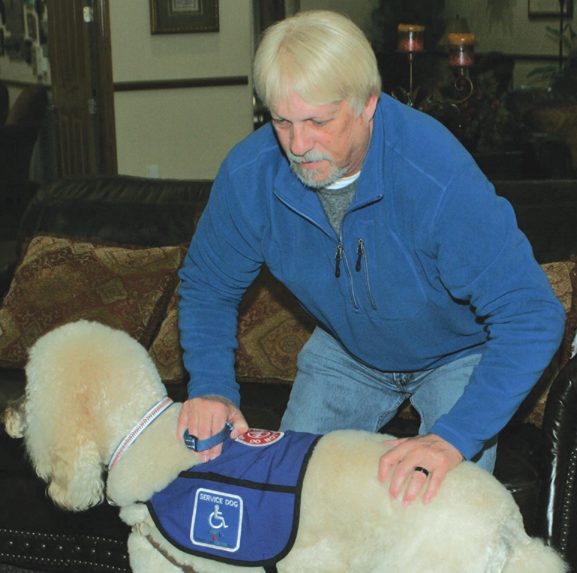Story and photos by Darl Devault, Feature Writer

Another National Aging in Place Month has come and gone in October. This year more seniors are retaining the independence and peace of mind of living at home by depending on the skills of a well-trained service dog.
With seniors seeking to stay in their homes as long as possible, working dogs facilitate this in several ways, including the slowing of cognitive decline. Dog training expert Barbara Lewis of Norman, Okla., urges seniors to consider a trained dog to enhance an aging-in-place agenda.
“A simple act of picking things up, opening doors, or letting you know when someone is at the door are critical skills to assist in independent living for years to come” said Lewis, chief executive office of A New Leash on Life in Norman.
Taking dogs on walks provides seniors the benefits of physical activity. And a well-trained canine can do so many tasks for the aging senior. Among these tasks, a service dog can serve as a brace for owners when rising from a chair or fetch items out of a dryer in the laundry room.
Lewis is addressing the absence of information about this important topic for seniors. “What I see missing most is the idea the actual training of a working dog (service or therapy) is only part of the job when preparing a dog for an owner,” Lewis said. “Determining the needs of the owner, finding the right working dog, and making sure the owner is properly matched to the dog are also key tasks.”
For a senior living alone, the additional benefit of companionship for a senior living alone should not be overlooked. Trained dogs generally provide a friendly and comforting presence in an otherwise empty nest.
Many seniors have already experienced the life-changing, positive aspects of owning an intelligent canine. With adequate preparation and training, most seniors can handle the new responsibilities of owning a service dog. Lewis’s nonprofit New Leash on Life combines her extensive background in dog training with her practical experience placing service and therapy dogs
Service dogs are now asked to perform a variety of tasks for seniors and people with disabilities, some duties just based on the owner’s aging body needing assistance. Dogs can provide help in opening doors and carrying items, while helping increase a senior’s self-confidence and self-reliance. Each animal is different and can be trained in tasks tailored to an individual’s unique requirements for living at home and when in public.
Therapy dogs—once largely seen only at nursing homes—are now used for emotional support and motivation in schools, libraries, courts, universities, hospitals, churches and employee lounges.
Still, a trained dog has limitations, Lewis warns. One challenge is what people expect service dogs to do. Owners need to understand the needs—and limitations—of their dogs. They are not machines with an on-off switch. And sometimes even a well-trained dog has an off day.
Some dogs are not inherently suited to perform the type of tasks needed by the owner. And some canines perfectly trained for their requirements fail as a result of inappropriate demands or the owner’s behavior.
An important question is whether a senior can train a dog to help them with their unique needs without outside expertise? In general, the answer is yes—sometimes. People without the means to pay for training may be able to successfully train their dog themselves. They may even bond better with their canine because of it.
Another pressing question for seniors is how long does it take to train a service dog? Many organizations, like Power Paws, train their service dogs from birth to two years of age before setting the dog with a handler.
Dog owners should note that training is a lifelong process for service animals. Without practice, dogs may forget their skills. Handlers should be prepared to work with their dogs to sharpen skills for the duration of the dog’s life.
Seniors need to be proactive in securing help from a service dog, educating themselves about the ins and outs of acquiring this assistance. At the outset of this journey they must determine exactly what they need from their newly trained dog.
Insight for this can be gained from a book recently published. Successful Working Dogs, an inexpensive, fully-illustrated guidebook written by Lewis. The book, provides readers positive-motivation training techniques for their service dog. It also provides information on how to evaluate the suitability of a working dog and its owner.
This book helps trainers—and dog owners in general—to understand the capabilities, needs and limitations of these dedicated animals.
The book can be purchased online from New Leash on Life at its website: http://newleashinc.org.
YOU MAY QUALIFY FOR THIS STUDY! CALL 405-447-8839 TODAY.
A SIMPLE COLD CAN LEAD TO SERIOUS ILLNESS
Now enrolling for a research study that may prevent or reduce illnesses from respiratory tract infections.
Respiratory tract infections are caused by viruses and are serious – espeically for people with asthma and for those over 85. They occur in the nose, throat and lungs and may include:
Common Cold – Influenza and influenza-like illnesses (“the flu”) – Bronchitis or “chest infection” – Pneumonia
The PROTECTOR 2 Study is evaluating an oral investigational drug to see if it may reduce or prevent illnesses from respiratory tract infections.
You may qualify if you are 85 years or older – Are in stable medical health
If you qualify, you will receive all study-related medical care at no cost and may be reimbursed for time and travel expenses related to study visits.
To learn more and to reserve your spot in this study…call 405-447-8839
Lynn Institute of Oklahoma City
3555 N.W. 58th st., Suite 800 OKC, OK 73112
Restorbio
(RTB-101-205_Event Poster_US_Eng_19SEP2019)















